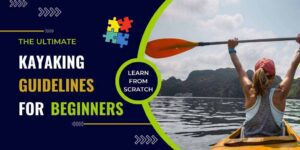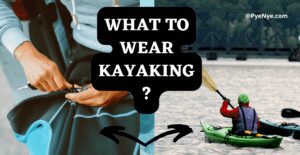The art of kayaking takes some practice and knowledge. Paddling aims to propel the kayak with minimal effort while maintaining control and stability. You can find yourself fighting against the current, tired, and uncomfortable if you don’t use the proper technique for paddling a kayak.
To begin with, the right body position is crucial for proper kayak paddling technique. It’s important that you sit upright with your feet firmly on the footrests. Bending your knees slightly and lower back firmly pressed against the seatback. By doing this, you’ll keep your balance and distribute your weight evenly.
Having a good understanding of these techniques will help you perform better and prevent you from getting hurt!
In this article, we will delve into the intricacies of the kayak paddling technique, including the correct body position, paddle grip, and stroke techniques, to help you make the most of your time on the water.
So, let’s explore the proper techniques for paddling a kayak!
Jump To A Section
Proper Technique for Paddling a Kayak
If you’re looking for an exhilarating water adventure, kayaking is definitely a must-try! But before diving into the water, you must learn the proper technique to ensure a comfortable and efficient paddling experience.
Getting the four basic strokes down can make you a better kayaker. They’re forward, reverse, sweep, and draw strokes. And you’ll also need to learn the J-stroke and bracing. In addition to making paddling easier and more efficient, it helps reduce fatigue and injury risks.
First, you need to ensure you’re sitting comfortably in the kayak. A good posture is crucial, so keep your back straight and your legs slightly bent to maintain balance and stability. Engaging your core muscles will also help you stay in control of your kayak.
Now, let’s talk about hand position and gripping. Proper gripping of the paddle is essential to ensure a successful kayaking trip. Make sure your hands are in the right position on the paddle, with the blade facing down and away from you. To prevent arm strain, keep your hands relaxed and your arms in a straight line.
When you’re ready to hit the water, remember that your sitting position plays a significant role in your paddling experience. Your knees should be slightly bent and pointing outward to give you the most control over your kayak. Keep your arms and elbows tucked in to maintain a good posture, and remember to engage your core muscles to stay balanced.
Let’s dive into the guide!
Kayaking Posture and Grip
You may wonder how to maintain proper posture and grip if you’re new to kayaking. Luckily, we’ve got you covered with some tips and tricks to ensure you’re paddling like a pro in no time.
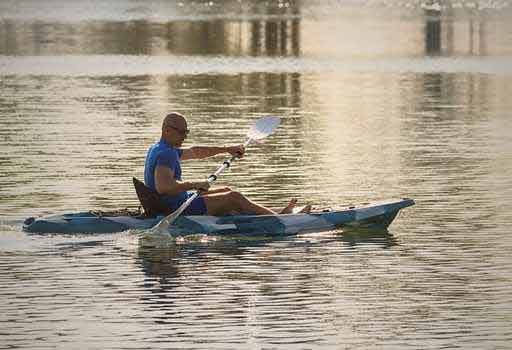
First things first, maintaining good posture and grip is essential to efficient paddling. Make sure your back’s straight, your arms and elbows tucked in, and your core engaged to keep your kayak balanced.
Then you can enjoy your time on the water without feeling tired!
Sitting
When it comes to sitting in the kayak, remember to keep your back straight. For optimal control, bend your feet and point your knees outward. It is also important to keep your arms slightly bent and your elbows tucked in.
Grip
Now, let’s talk about the proper way to grip your kayak paddle. This is important not only for efficiency but also to prevent soreness and fatigue. First, make sure your hands are in the right position on the paddle.
The paddle should rest in the “V” between your thumb and index finger, with the blade pointing down and away from your body. Your grip should be relaxed, not too tight, to prevent fatigue.
Arm position
Lastly, your arms should be in the correct position, slightly bent at the elbows and in a straight line, with the paddle extending to your chest. This ensures that you’re paddling with the correct angle and not straining your arms unnecessarily.
Techniques For Different Paddling Strokes
Whether you’re a seasoned kayaker or a newbie, mastering the basic strokes can make a huge difference in your kayaking experience. Let’s take a closer look at the four basic strokes that every kayaker should know and understand.
The Forward Stroke
There’s nothing like a classic forward stroke. It’s the bread and butter of kayaking. And every kayaker needs to master this one!
Getting the right posture and hand placement is key to a successful forward stroke. Use your hands and wrists to push down on the paddle. Keep your elbows close to your body. To move efficiently and effectively through the water, you’ll need to twist your torso to generate power.
The Reverse Stroke
Need to slow down or move backward? The reverse stroke is your go-to move. Similar to the forward stroke, the reverse stroke requires proper body posture and hand placement. Extend your arms straight out, and apply pressure to the paddle with your hands and wrists. The key difference is that you’ll be pulling the paddle blade toward your hip instead of pushing it away.
The Sweep Stroke
Turning your kayak can be difficult. With the sweep stroke, you can navigate tight corners effortlessly. This stroke involves pushing the paddle blade away from your kayak and pulling it back in the opposite direction of travel. Make sure your elbows are close to your body, your arms are straight, and your hands and wrists are on the paddle. It’ll help you turn your kayak smoothly.
Getting these basic strokes down is key to kayaking success. It’ll not only make you more efficient on the water, but it’ll also make paddling more fun. So get out there and practice!
Advanced Kayak Paddling Technique
Are you ready to level up your kayaking game and take on new challenges? Well, if you want to make the most out of your time on the water, it’s important to master the proper use of your paddle. Whatever your skill level, mastering the right technique is the key to success. To become an efficient and effective kayaker, you need to focus on a few key things, like bracing, hand positioning, and stroke technique. So let’s dive a bit deeper and explore what it takes to become a true paddling pro!
J-stroke
The draw stroke is a more advanced paddling technique used to move the kayak forward. Draw strokes require paddlers to keep the blade vertical and move the paddle away from and towards the kayak. As the paddle approaches the kayak, the paddler should arch it away from themselves. This will generate power and propel the kayak forward.
To properly execute a J-Stroke, the paddler needs to keep their paddle blade vertical and create a “J” shape with their strokes. The paddle should move from side to side, and the paddler should keep their arms close to their body. As the paddle moves from side to side, the kayaker will be able to generate enough power to turn the kayak in the desired direction.
Sculling Stroke
Sculling is a kayaking technique that allows you to generate more speed and power. In order to use it, you hold the paddle blade vertically and scull your arms from side to side. With their arms close to their bodies and using their arms to generate power, kayakers can control and move their kayak with greater accuracy.
Typically, more experienced kayakers use this technique since they understand the power of the sculling stroke. To do the sculling stroke correctly, you’ll need strength and coordination. Also, it’s important to find a comfortable position where your arms can move freely so you’re more efficient. After mastering the technique, the kayaker will have more control and speed.
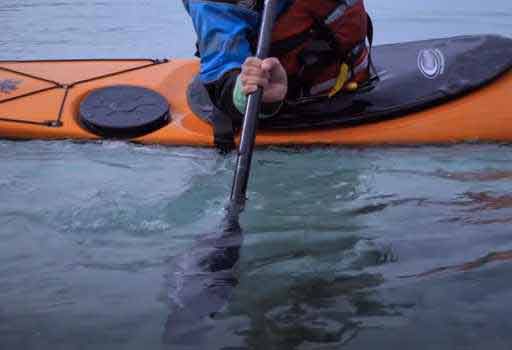
In addition to providing more control, the sculling stroke also helps the paddler move their kayak with greater speed and power. This is because the paddler is able to generate more power and speed with each stroke. As a result, the paddler can move the kayak faster and with more control.
Bracing
The bracing stroke is a powerful move that uses the paddle to press against the water and against the sides of the kayak. This helps to stabilize the kayak and keep it from capsizing or flipping. The bracing stroke is done by firmly gripping the paddle with the upper hand and pressing the paddle against the water with the lower hand. This provides both stability and power, allowing the kayaker to push their kayak forward.
Related: Learn To Rescue A Kayak When It Capsizes
Bracing is especially important in rougher waters, where waves and strong currents can cause the kayak to become unstable. Knowing how to brace is key to having a safe and enjoyable kayaking experience. Before taking to the water, it is important to practice and gain confidence in the bracing stroke.
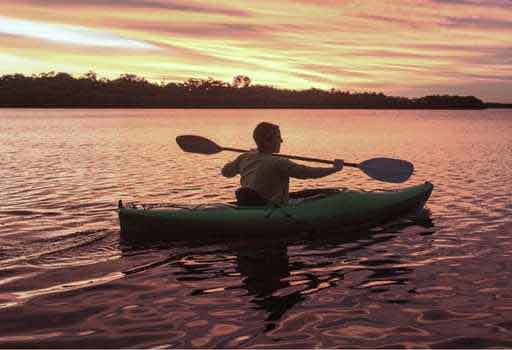
In addition to bracing with the paddle, a kayaker can also use their body to brace themselves. This can include leaning into the side of the kayak or using the paddle blade to press against the hip or shoulder.
It is important to remain aware of the body position and use the paddle and body in tandem to stay upright and in control.
Turning And Maneuvering
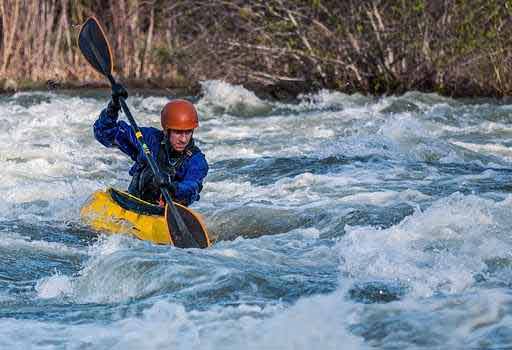
The most common way to turn and maneuver a kayak is with paddling strokes. To turn the boat, you’ll need to use forward and backward strokes with your paddle to direct the boat in the desired direction.
When turning to the right, you’ll use a forward stroke on the left side of the boat and a backward stroke on the right side, and vice versa for turning to the left.
Power-Turn
Another key aspect of advanced kayak paddling techniques is learning how to perform a power turn. A power turn is a technique that allows you to make a sharp turn in the kayak without having to slow down.
To perform a power turn, you need to use your body weight and a strong paddling stroke to make a sharp turn in the direction you’re paddling. This technique can be used to navigate tight turns and navigate around obstacles.
Safety Techniques For Paddling A Kayak
Paddling a kayak is a great way to explore the great outdoors, but it’s important to stay safe while doing so. The key to staying safe while paddling is following proper safety techniques and wearing the right safety gear.
When paddling in open water, it is important to be aware of the conditions. Pay attention to the weather and the currents so that you can stay safe. Also be aware of any obstacles, such as rocks or logs, that might be in your path. Taking a course from a qualified instructor can help you learn proper safety techniques for paddling in different conditions.
Rescue techniques
Kayaking is a fantastic way to explore the great outdoors, but when you’re out on the water, safety is of the utmost importance. If you find yourself in trouble and need to be rescued, knowing the proper kayak rescue techniques can make all the difference.
Here, we’ll cover the various kayak rescue techniques, how to use them, and when they should be employed.
T-Rescue
The T rescue is a common rescue technique for kayakers. In this rescue, two kayakers use their bows to help each other turn their kayak, or “T” it. During the T-rescue, the kayaker in need of help holds the bow of their kayak up in the air while the other kayaker pulls the stern (back) around in a circle. This rescue technique is more effective in strong currents.
C-Rescue
C-rescue is a slightly more advanced technique used when a kayaker is in trouble and unable to hold onto their kayak. To perform the C-rescue, the kayaker needs to grasp the stern (back) of his kayak while reaching out for help. Once the kayaker is upright, the other kayaker will use their kayak to pull their kayak in a C-shape. It’s best used in rough water or strong currents because it involves more coordination between the kayakers.
Through Bag-Rescue
Finally, the Throw Bag rescue technique is used when a kayaker is in trouble and unable to reach their kayak. To perform the Throw Bag rescue, the kayaker in need of help should reach out for the throw bag that the other kayaker is holding. The other kayaker should then throw the bag toward the kayaker in need of help, and the kayaker should grab onto the bag and be pulled towards their kayak.
This technique can be difficult if the water is choppy or strong currents are present.
Communication While Paddling
As a paddler, it’s important to understand the importance of communication techniques in order to stay safe, be mindful of other paddlers, and protect the environment.
Good communication is essential for any paddling trip, whether it’s a short-day trip or an overnight kayak expedition. It’s important to communicate with your fellow paddlers, either verbally, using hand signals, or visually. Doing so will help ensure everyone is on the same page regarding route, speed, and safety.
When it comes to verbal communication, it’s important to be as clear and concise as possible. Using phrases like “keep left/right” or “prepare to turn” can help other paddlers know what you’re doing ahead of time. It’s also important to speak up if you notice something unexpected or dangerous, like an oncoming boat or other obstacles.
Hand signals can also be a great way to communicate with other paddlers. Pointing, waving, and pointing with your paddle can all help other paddlers know what you’re about to do. You can also use hand signals to let other paddlers know to stay out of your way or to indicate when it’s safe to pass by.
Visually, you can use your kayak or paddle to indicate what you’re doing. Pointing your paddle to the left or right can indicate which direction you intend to turn. You can also use your paddle to indicate the speed you plan to paddle, such as waving it up and down for a slow pace or holding it up high for a faster pace.
By mastering these communication techniques, you can ensure everyone on the trip stays connected and can get back when needed. This will help you get the most out of your paddling experience while also keeping everyone safe. So next time you hit the water, make sure you practice your communication techniques and have a great time!
Keep Practicing
When you first begin kayaking, learning the proper technique can be difficult. It requires a combination of physical and mental skills as well as a good understanding of the kayak, its parts, and how they all work together. Through practice and dedication, you can become an experienced and knowledgeable paddler. Here are a few tips to help you master the proper technique for paddling a kayak:
Learn the Basics: Before getting into the kayak, learn the basics of paddling, such as how to hold the paddle correctly and the difference between a forward stroke and a backward stroke.
Get Comfortable: When you are comfortable in the kayak, you will be able to paddle more efficiently and with less effort. Make sure you’re properly adjusted to the seat, foot brace, and backrest before you begin.
Practice Makes Perfect: Spend time practicing the proper technique for paddling. This will help you become more familiar with the kayak and how it moves in the water, which will make your experience more enjoyable and efficient.
Stay Dry: Make sure you stay dry while paddling, especially in cold weather. Wear a dry suit or a wetsuit to keep your body temperature regulated and your core warm.
Be Patient: Kayaking takes time and dedication to master. Be patient with yourself and take your time learning the proper technique.
Final Words,
Learning the proper technique for paddling a kayak is essential to enjoying the sport. With practice and dedication, you can become an experienced and knowledgeable paddler. By following these tips, you can master the proper technique for paddling a kayak and enjoy the incredible experience of paddling on the water.
